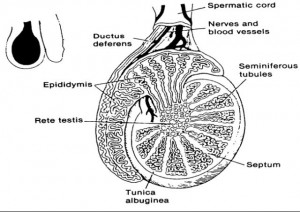a. Testes (Two).
The testes are two almond-shaped glands whose functions are for the production of sperm and testosterone.
The testes are suspended in the scrotal sac outside the abdominopelvic cavity. It is believed that the testes lie outside the body cavity because they are very sensitive to heat and the higher temperature within the body is unfavorable to the production of sperm.
Each testis is enclosed by a tough, white fibrous capsule called the tunica albuginea. Extension of the capsule divides it into a large number of lobes. Each lobe contains four tightly coiled seminiferous tubules (this is the location of actual sperm production). The seminiferous tubules empty sperm into the testicular network where they travel to the epididymis. The epididymis is located outside of the testis (see figures 1-8 and 1-9).

b. Duct System.
The duct system is the passageway for the sperm to exit the body. It contains the epididymis and the vas deferens. (1) Epididymis. The epididymis is a coiled tube about 20 inches long. It caps the superior part of the testis and runs down its posterior side. It forms the first part of the duct system and provides a temporary storage site for immature sperm.
When the male is sexually stimulated, the walls of the epididymis contract to expel sperm into the next part of the duct system. (2) Vas deferens (ductus deferens). The sperm continue their journey through the vas deferens. The vas deferens runs upwards from the epididymis through the inguinal canal into the pelvic cavity and arches over the bladder (see figure 1-8). It is enclosed with blood vessels and nerves in a connective tissue sheath, which is called a spermatic cord. The vas deferens empties into the ejaculatory duct that carries the sperm through the process to empty into the urethra.
c. Accessory Glandular Structure.
The accessory glandular structure includes the seminal vesicles, prostate gland, Cowper’s glands, and the penis.
(1) Seminal vesicles. The two seminal vesicles are pouches that store sperm. Sixty percent of fluid volume of semen (seminal fluid) is produced there. The secretion is rich in sugar (fructose), which nourishes and activates the sperm passing through the tract.
(2) Prostate gland. The prostate gland is a single gland about the size and shape of a chestnut. It encircles the upper area of the urethra just below the bladder. It secretes a milky alkaline fluid, which has the role in protecting the sperm against acid conditions of the vagina.
(3) Cowper’s glands. The cowper’s glands are tiny pea-sized glands inferior to the prostate. They form a thick, clear mucus, which drains into the urethra. The secretion is believed to serve primarily as a lubricant during sexual intercourse.
(4) Penis. The penis is a cylinder-shaped organ located externally on the mons pubis, immediately above the scrotum. It is made of erectile tissue with cavern-like spaces in it. At the time of sexual excitement, blood fills these spaces, changing the soft, limp penis to an enlarged, rigid, erect organ.
The smooth cap of the penis is called the glans penis and is covered by a fold of loose skin that forms the headlock foreskin. Surgical removal of this foreskin, called circumcision, is frequently performed. The penis also serves as part of the urinary tract in the male.
